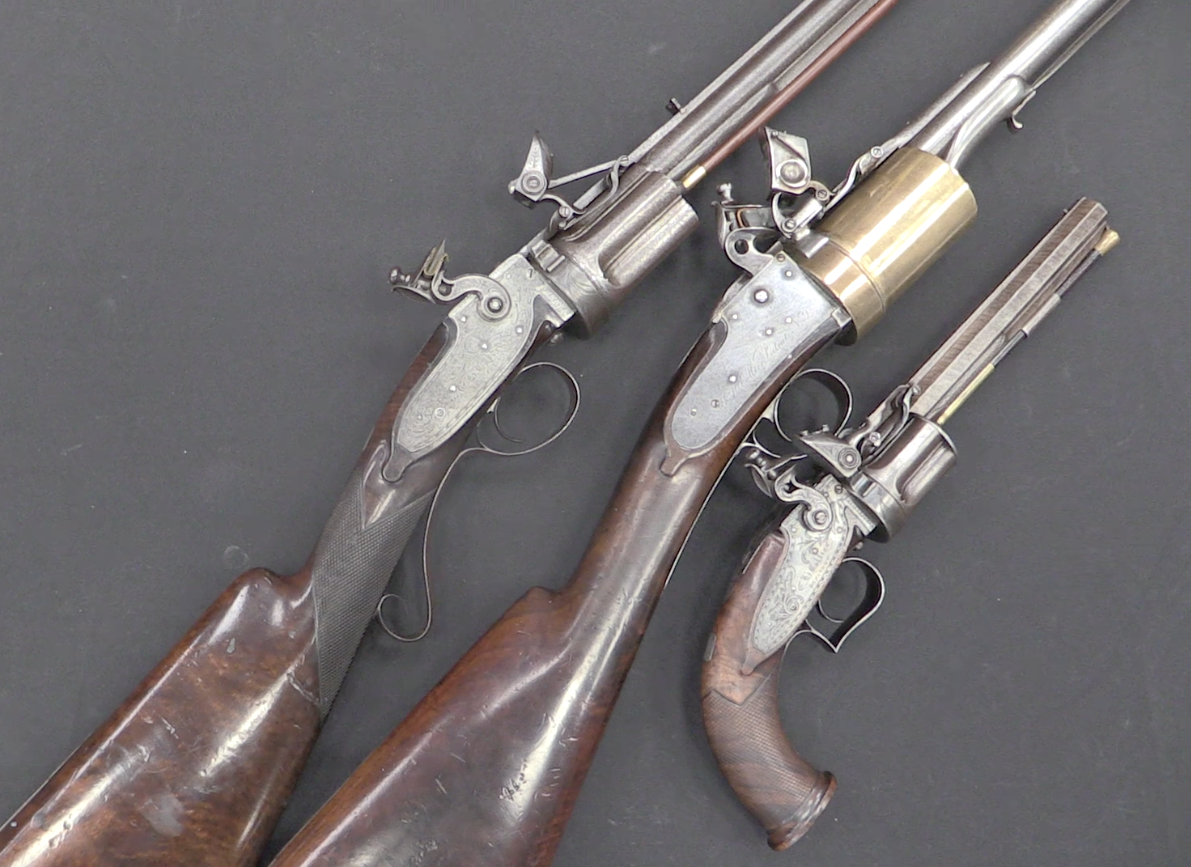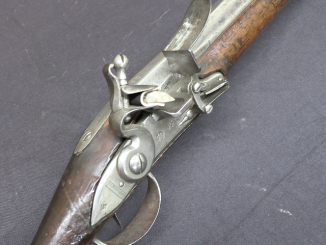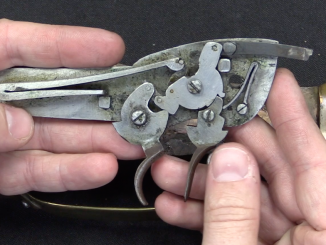Lot 1197 in the September 2019 RIA auction.
John Parker Lindsay patented a superposed, 2-shot muzzleloading rifle action in 1860, and remarkably, was able to get a contract to sell them to the US Federal Army. The system was fairly simple, with two percussion caps and firehouse leading to a front and rear chamber. The rifle was loaded with two successive charges of 60 grains of black powder and 500 grain bullets, and a single trigger fired the two rounds in succession.
In August 1863 the rifle was tested at West Point by Captain S.V. Benet and found acceptable. In fact, Benet found that the pressure from firing the first round tended to very firmly seat the second round, which then cleared fouling from the bore better than a regular rifle when it was fired. A contract was signed in December of 1863 for Army purchase of 1,000 Lindsay rifles at $25 each, and they were delivered in August of 1864. The rifles were issued to the 16th Michigan Volunteer Infantry, and saw use in the Battle of Peeble’s Farm.
Both in battle and in extended testing, the rifles were found to be flawed in ways they had not been initially recognized. Troops complained of double shots, with a single trigger pull firing both charges. Testing also found that the front chamber fire tube tended to foul and plug too easily, rendering the front chamber impossible to fire. No additional Lindsay rifles were purchased by the military. Lindsay did also make several versions of handgun using his system – these sold better than the rifles, but were still not a commercial success by most standards.




Good intentions poorly implemented and poorly received tend to make the inventor miserable. The superimposed load idea doesn’t work cheaply in modern crafting, if a particular Metal Storm comes to mind…
“(…)Good intentions poorly implemented and poorly received tend to make the inventor miserable.(…)”
Well, I am wondering how John Parker Lindsay imagined usage of his invention in real combat? Problem is that in stressful situation it does provide additional opportunities to fail (like for example loading twice, when it is already one-loaded), when compared to single-shot percussion weapon and there exist archeological evidence that in 1860s some soldiers during battle loaded their single-shot weapons more than once:
https://history.stackexchange.com/questions/19077/mystery-of-the-many-loaded-muzzles
Additionally this weapon in order to exploit its main selling point, would need special drill, different from most others.
“Metal Storm”
superimposed weapons require special ammunition, which should be not only case-less*, but also, can not have primer in standard location. But things get really complicated if you start to think: how to remove dud cartridge from superimposed?
* or kinda case-less, for example I suspect, that 9 mm AUPO https://modernfirearms.net/en/submachine-guns/italy-submachine-guns/benelli-cb-m2-eng/ could be possibly used in superimposed manner.
In some cases, the soldiers who had multiple loads in their guns were too busy trying to keep up with their squad-mates and just got over-stressed. They didn’t notice that they’d forgotten to discharge their weapons! Other cases were attributed to poorly maintained weapons (with issues like bent barrels and broken trigger sears).
It is same idea as in Walch revolver https://en.wikipedia.org/wiki/Walch_Revolver
which was produced in very similar time, so I am wondering if John Walch was inspired John Parker Lindsay or in reverse or they develop their weapons independently?
Not exactly the same, in that the second flash hole isn’t elongated, but it is an older idea. https://www.thefirearmblog.com/blog/2017/07/27/close-look-ellis-jennings-repeating-flintlock-rifle/
Most surviving Lindsay rifle-muskets show greater wear on the left hammer and nipple. This indicates that most users were using it as a standard single-shot weapon and ignoring the “double shot” feature entirely.
Also, if under stress a man were to load one round, but then cap the right nipple and try to fire, the cap flame probably would not wash around the bullet enough to ignite the “rear” charge.
In short, the Lindsay probably wasn’t as useful as a standard rifle-musket loaded with a “buck and ball” load.
As for the various Lindsay handguns, the existence of revolvers like the Colt, which by that time had been around for almost a quarter-century, the British Adams, which had been available since 1852, and the Smith & Wesson, which used rimfire metallic cartridges, rendered the Lindsay pistols no more than curiosities.
In fact, that’s about the best thing you can say about the rifle version, as well.
cheers
eon
Now Mr. Lindsay’s got me visualizing a side by side double barrel rifle musket with a unique double ramrod shaped like a VERY long tuning-fork. Having set both hammers to half-cock and grounded your piece per gummint reg’lations, loading drill would go: 1) bite first cartridge, 1.1) empty powder into right barrel, 1.2) seat Minnie ball and wadded cartridge paper in right muzzle, using the authorized thumb, 2) bite and repeat for left muzzle, 3) withdraw and reverse ramrod, 4) present both rod cups to the muzzles, 5) ram and tamp both charges/bullets at once, 6) reverse and reseat ramrod, 7) hoist musket to port arms position, 8) remove spent caps, if any, from BOTH nipples, 9) cap BOTH nipples with fresh caps, 10) upon command, shoulder musket, 11) aim, and 12) fire BOTH barrels, AIMING BOTH TIMES, YOU #@$%&^*!!!! YARDBIRD! If you could train those yokel conscripts to seat the bullets/wads in both barrels before ramming, you’d cut down on double loadings, although nothing within the scope of human ingenuity will ever entirely defeat Gomer and his ways.
What would you gain by issuing double barrel rifle muskets? Why, nothing, beyond two extremely quick first volleys. But the Rebs wouldn’t appreciate even that much Yankee ingenuity, when it come time to see the elephant.
“Why, they couldn’t shoot an elephant from this distance!” BLAM! A regular musket is good enough, if emphasis is placed on making sure that everyone’s weapon is in good working order. As for firing on command, the captain should probably have his men drilled well to avoid accidental double-loading. There is nothing like a lack of good training to really screw you over when the time comes to go into battle.
“Why, they couldn’t shoot an elephant from this distance!” BLAM!
Poor Sedgewick, He was going places before the Angle 🙁
I stupidly passed on purchasing one of these in 1994 in unissued condition for $900.00. Of course, it would have not stayed in that condition had I purchased it…
I think enough muzzle loaders were disabled by soldiers loading them ‘bullet down’ to account for many of the abandoned guns on Civil War battlefields. The Lindsay would offer a geometrically increased opportunity for mishaps.
I can see the complaint about flash hole fouling being legitimate. I suspect that the complaints about doubling had more to do with the relatively short reset, and an unintentional second trigger pull while under recoil.
Kind of like we’ve seen doubles with super magnum double action revolvers.
Thank you for providing information about the army’s gun.